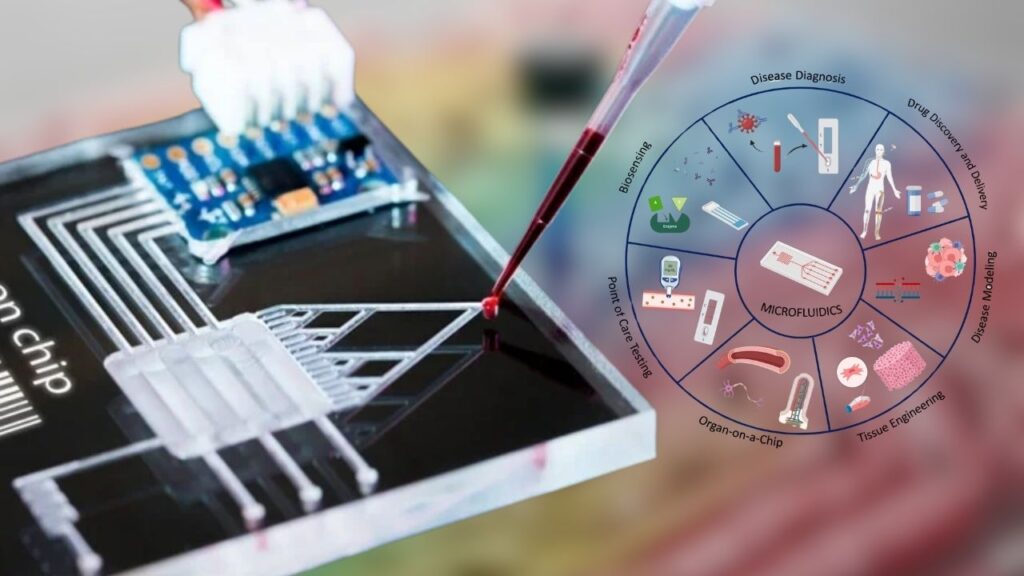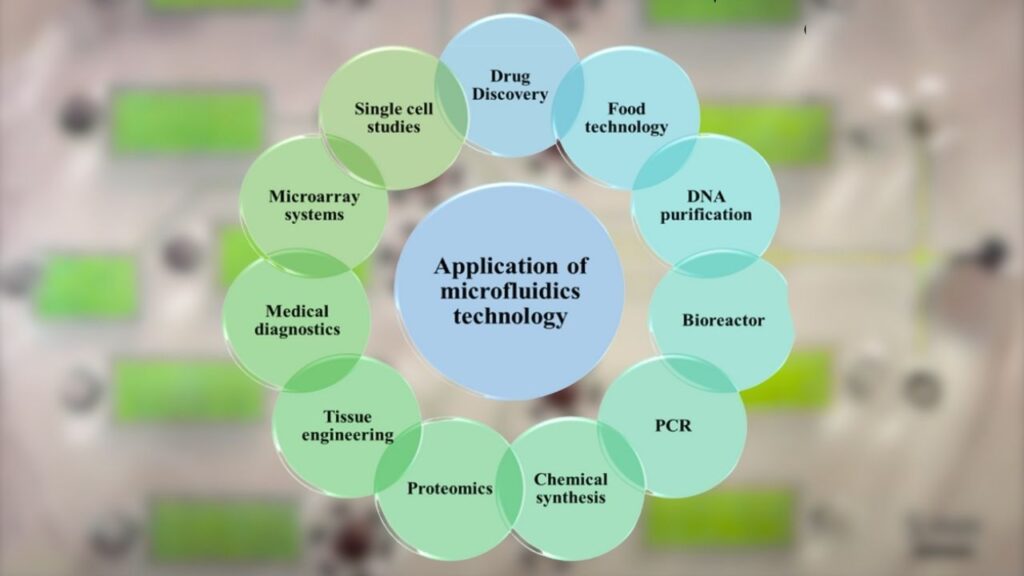Microfluidic Technology: Microfluidic technology is rapidly transforming the world of biomedical research. By precisely controlling the movement of tiny droplets and particles within channels thinner than a human hair, scientists are uncovering the complex pathways that particles—like cells, drugs, and even viruses—take inside our bodies. This breakthrough is paving the way for new discoveries in medicine, diagnostics, and personalized healthcare.

Microfluidics, sometimes called “lab-on-a-chip” technology, allows researchers to perform experiments that once required entire laboratories, all on a chip the size of a postage stamp. This article breaks down how microfluidic technology works, why it matters, and how it’s changing the future of medicine for both professionals and curious minds alike.
Microfluidic Technology
| Feature/Insight | Details & Data |
|---|---|
| What is Microfluidics? | Science of controlling fluids at micro/nano scale, often in channels smaller than a hair |
| Major Benefits | Faster analysis, low sample/reagent use, high precision, automation, cost reduction |
| Key Biomedical Applications | Disease modeling, drug testing, point-of-care diagnostics, tissue engineering, organ-on-a-chip |
| Notable Stats | Microfluidics can reduce reagent use by up to 99% and analysis time by over 50% |
| Career Opportunities | Biomedical engineer, microfluidics researcher, lab-on-a-chip developer, biotech product designer |
| Official Resource | Elveflow Microfluidics |
Microfluidic technology is unlocking new pathways in biomedical research by allowing scientists to study the movement and interaction of particles at a microscopic level. Its ability to mimic the body’s environment, speed up experiments, and reduce costs is revolutionizing how we diagnose diseases, develop drugs, and personalize medicine. Whether you’re a student, a seasoned researcher, or just curious, microfluidics is a field that promises to shape the future of healthcare.
What is Microfluidic Technology?
Microfluidics is the science and technology of systems that process or manipulate tiny amounts of fluids, usually in the range of microliters (one-millionth of a liter) or nanoliters (one-billionth of a liter), using channels with dimensions of tens to hundreds of micrometers. Imagine a maze so small that only a single cell or a droplet of blood can fit through at a time.
These microfluidic devices, often called chips, use the unique physical and chemical properties of fluids at such small scales. This allows scientists to perform complex experiments—like mixing chemicals, analyzing DNA, or growing cells—quickly, cheaply, and with very little material.
Why is Microfluidic Technology Important?
Microfluidics offers several advantages over traditional laboratory techniques:
- Speed: Experiments that once took hours or days can now be completed in minutes.
- Efficiency: Uses much less sample and reagent, reducing costs and waste.
- Precision: Allows for highly accurate control of experimental conditions.
- Automation: Many steps can be automated, reducing human error and freeing up scientists’ time.
- Portability: Devices can be small and portable, enabling point-of-care diagnostics even in remote locations.
How Does Microfluidic Technology Work?
At its core, a microfluidic device is like a tiny plumbing system. It contains:
- Microchannels: Tiny pathways that guide fluids.
- Valves and Pumps: Control the movement and mixing of fluids.
- Sensors: Detect changes, such as the presence of a disease marker or the reaction of a drug.
For example, a drop of blood can be placed on a microfluidic chip. The chip can then separate the blood into its components, test for diseases, and send the results to a computer—all in a matter of minutes.
Real-World Applications in Biomedical Research
1. Disease Modeling and Drug Testing
Microfluidic chips can mimic the environment of human organs, such as the lung or liver, allowing researchers to study how diseases develop and how drugs work—without needing to test on animals or humans first. This is known as organ-on-a-chip technology.
Example: Scientists can grow human lung cells on a chip and expose them to viruses or pollutants to see how the lung responds. This helps in developing new treatments for diseases like asthma or COVID-19.
2. Point-of-Care Diagnostics
Because microfluidic devices are portable and require very little sample, they are perfect for rapid diagnostic tests. These are especially useful in areas without advanced laboratories.
Example: Paper-based microfluidic tests can detect diseases like malaria or COVID-19 from a single drop of blood, providing results in minutes.

3. Personalized Medicine
Microfluidic technology enables tests that are tailored to an individual’s unique biology. Doctors can use chips to test how a patient’s cells react to different drugs, helping to choose the most effective treatment.
4. High-Throughput Screening
Microfluidics allows scientists to run hundreds or thousands of experiments at once, speeding up the discovery of new drugs or understanding of diseases.
How Microfluidics Reveals Complex Particle Pathways
One of the most exciting aspects of microfluidics is its ability to show, in real time, how particles like cells, proteins, or nanoparticles move and interact inside tiny channels. This mimics the conditions inside our bodies, such as blood vessels or tissues.
- Tracking Cell Movement: Researchers can watch how cancer cells migrate, which is key to understanding and preventing metastasis.
- Studying Drug Delivery: Scientists can observe how drug particles travel, stick to, or enter cells, helping to design more effective treatments.
- Understanding Disease Spread: By simulating how viruses or bacteria move through tissues, microfluidics helps in developing better vaccines and therapies.
Step-by-Step Guide: How Microfluidic Devices Are Used in Research
Step 1: Designing the Chip
Scientists design the layout of microchannels and chambers, often using computer software. The design depends on the experiment—whether it’s to mix fluids, grow cells, or test drugs.
Step 2: Fabrication
Chips are made using materials like silicone or glass. Advanced methods like 3D printing allow for rapid and precise production of complex designs.
Step 3: Sample Loading
Tiny amounts of fluid (like blood, saliva, or chemicals) are loaded onto the chip using pipettes or automated systems.
Step 4: Experimentation
The chip controls the movement, mixing, and reaction of fluids. Sensors and cameras capture data in real time.
Step 5: Data Analysis
Results are analyzed using computers, often with the help of artificial intelligence to spot patterns or make predictions.
Practical Advice for Professionals and Students
- Start Small: Many universities and companies offer starter kits for microfluidics. Begin with simple experiments to understand the basics.
- Collaborate: Microfluidics is a multidisciplinary field. Work with engineers, biologists, and data scientists for the best results.
- Stay Updated: The field is evolving rapidly. Follow journals and attend conferences to learn about the latest advances.
- Consider Careers: Careers in microfluidics span academia, healthcare, biotechnology, and even consumer electronics. Roles include research scientist, product developer, and diagnostics engineer.
Optimized Solvents Significantly Improve Carrier Mobility in Metal-Organic Frameworks (MOFs)
New Smart Material Brings Electronic Skin Closer to Reality for Robots and Human Prosthetics
World’s First Humanoid Robot Powered by Large Language Models Makes Public Debut
FAQs About Microfluidic Technology
Q1. What is microfluidic technology used for?
Microfluidic technology is used for disease diagnosis, drug development, studying cell behavior, and creating artificial organs on chips.
Q2. How small are microfluidic channels?
Channels are typically 10–100 micrometers wide—about the width of a human hair.
Q3. Are microfluidic devices expensive?
While initial setup can be costly, microfluidics saves money in the long run by using less sample and reagent per experiment.
Q4. Can microfluidics replace animal testing?
Microfluidic organ-on-a-chip models are reducing the need for animal testing, but are not yet a complete replacement.
Q5. Where can I learn more or buy microfluidic devices?
Visit Elveflow Microfluidics or check with major scientific suppliers.






